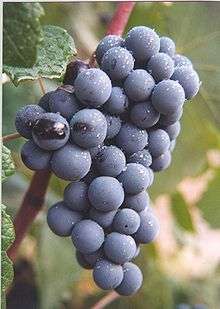Bobal

Bobal is a variety of Vitis Vinifera, a red grape used in winemaking. It is native to the Utiel-Requena region in Valencia, Spain. The name derives from the Latin bovale, in reference to the shape of a bull’s head. It is grown predominantly in the Utiel-Requena DO where it represents about 90% of all vines grown, and is also present in significant quantities in Valencia, Cuenca and Albacete. It can only be found in small quantities in other regions of Spain: La Manchuela (Castile La Mancha), selected vineyards in Ribera de Guadiana DO, Alicante DO, Murcia, Campo de Borja, Calatayud, Cariñena, Valdejalón. Small quantities are also grown in Rosellón (south of France) and in Sardinia (Italy). A rare white variety of the same name also exists. According to the data from the Spanish Vine Registry (Registro Vitícola Español) of 31 July 2004, Bobal is the third most planted variety in Spain with 90,000 ha (8%), coming behind Airén 305,000 ha (27%) and Tempranillo 190,000 (17%).
The best wines are deep, soft color. Bobal has traditionally been used for the production of bulk wine, but producers working in higher altitudes than 800 metres (2,625 feet) above sea level, as Bodega De Moya are taking this variety more seriously and give it the attention it deserves.
Description
The vine is very vigorous and highly productive, has a natural semi-erect posture, with long, strong, trailing shoots, which makes it a difficult vine to work in the summer. The shoots often completely cover the ground thus helping to conserve moisture during the hot summers.
It adapts well to all types of vine formation but is most commonly grown as a low bush (en vaso) and less often on trellises (en espaldera).
It is perfectly adapted to the local climate and so is resistant to extremes of weather and diseases.
The pulp is colourless and meaty; the hard skin of the round medium-sized berries is intensely and brightly coloured, the smell is fresh, original and fragrant. The taste is pleasantly acidic and tannic. The average bunch is of medium-large size, compact, with an irregular cone shape.
The must is normally high in colorants and tannins and is suitable both for aging and for coupage with other varieties. The must also contains higher than average quantities of resveratrol.
The wines produced tend to be fruity, low in alcohol content (around 11°) and high in acidity (5.5 to 6.5 tartaric acid)
Synonyms
Also known as bobos, rajeno, requena, espagnol, benicarlo, provechón, valenciana, carignan d'espagne, balau, balauro, tinto de requena, coreana, tonto de zurra, requenera, requení, requeno, valenciana tinta
History
The presence of Bobal in Utiel-Requena was documented in the 15th century in "Espill o llibre de les dones” by Jaume Roig.
Climate
The region of Utiel-Requena, located at 80 kilometres (50 miles) from the Mediterranean coast, at an altitude of between 700 and 950 metres (2,300 and 3,120 ft) above sea level has very little rainfall, about 430 mm (17 inches) per annum. There is a mixture of Mediterranean and continental climates, with long, very cold winters. There are late frosts in April and May and extreme daytime and nighttime temperature variations during the growing season. The Bobal vine protects itself from the frosts by sprouting late. It also ripens late thus allowing it to conserve acidity in the must. Being such a vigorous variety it has to be pruned back severely in order to limit its production.